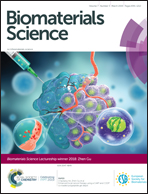Gradiently degraded electrospun polyester scaffolds with cytostatic for urothelial carcinoma therapy†
Abstract
Kidney-sparing surgery is the preferred treatment strategy for low-risk upper tract urothelial carcinoma (UTUC). However, after this procedure, prevention of the carcinoma recurrence in the ureter and supporting the ureter with a ureteral stent are necessary. Biodegradable drug-loaded ureteral scaffolds are able to maintain their long-term effective drug concentrations in the lesion sites without the defects of traditional ureteral stents, which may address both issues simultaneously. The purpose of this study was to reveal the possibility of the controlled delivery of epirubicin (EPI) via gradiently degraded electrospun poly(ε-caprolactone) (PCL)/poly(lactide-co-glycolide) (PLGA) scaffolds to evaluate their antitumor activity against UTUC. The degradable PCL/PLGA scaffolds containing 15.0 and 25.0 wt% PCL and loading of 0, 5.0, and 10.0 wt% EPI were successfully fabricated via electrospinning. In addition, the PCL/PLGA scaffolds showed sustained and controlled degradation and drug release kinetics, that is, their degradation and drug release rates slowed with an increase in the ratio of PCL. The EPI-loaded PCL/PLGA scaffolds showed excellent antitumor activities both in vitro and in vivo without apparent systemic toxicity. Overall, the gradiently-degraded EPI-loaded electrospun polyester scaffolds are potential ureteral stent tubes for the local inhibition of the recurrence of UTUC, where the continued release of EPI can prevent the subsequent proliferation of residual tumor cells, and the gradient degradation is consistent with the repair of the ureter.



 Please wait while we load your content...
Please wait while we load your content...